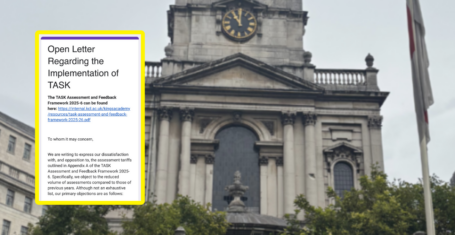
In Conversation with the SU: Safety concerns after student dies on Bristol Uni swimming trip
The society was not given a safety brief or specific risk assessment and no lifeguard or floatation devices were available
Last June, Jack Lees, a bright neuroscience student at the University of Bristol, tragically died after rescuing three swimmers at a Bristol Student Union Society swimming trip. His death was preventable.
I spoke exclusively with Christy O’Sullivan, Bristol SU’s Director of Student Opportunities & Community to understand the health and safety policies which were in place that day, and what has changed since.
On the trip, there is no evidence there was a site-specific risk assessment, no safety brief was given, no lifeguard was present, no evidence of floatation devices being available, and students were swimming in an outgoing tide.
(The questions were written by Laura in collaboration with Dawn)
First I asked about the SU’s duty of care to students.
The legal duty of care towards students is muddy for both Universities and SUs, something which has continuously come under public scrutiny in cases such as the death of Natasha Abrahart.
Christy said: “As a charity, we exist to support students at the University of Bristol. In everything we do, we aim to support their safety and wellbeing.”
With this, I wanted to know if students are safer taking part in activities under the umbrella of the SU and why.
Christy explained the support which affiliated groups receive, aiding them to “provide safe and enjoyable experiences to members.”
Adding: “We would expect student groups to be safer than external groups that don’t have these things in place.”
Christy explained how the SU’s role is to ensure groups adopt best practices, acting as “an authority holding them to account.”

Image the SU provided as part of their response
Most Read
Risk assessments were a core area of enquiry in the inquest into Jack’s death. Christy explained the requirement for groups to undertake trip-specific risk assessments in addition to an annual one. She said: “This is mandatory and everything they submit as part of their trip registration (including their risk assessment, itinerary, list of participants etc.) is checked, before SU approval is granted. ”
However, for the Bristol Student Union Wild Swimming Society trip to Bude, which led to Jack’s death, there was no evidence of a trip-specific risk assessment. This requirement was brought in this academic year, and the SU were “in the process of moving to this requirement during the academic year 2023/24.”
Christy added: “The risk assessment for the trip should cover any new, additional or increased risks that are specific to the trip. This could be around the travel and accommodation (especially for overseas trips) or if unfamiliar locations are being visited.
“If a group repeatedly uses the same site, we’d expect that to be documented in the risk assessment. If their activity changes site then we would expect them to make a dynamic risk assessment which would include assessing things on the day, ahead of or during activity taking place. This means that in the case of changing conditions, environmental factors, or unforeseen risks, the group can respond to that risk and take necessary action.”
The trip to Bude was in its fourth year running. However, a quick Google of Bude will reveal rip currents are a common occurrence. In the two months after Jack’s death, at least 9 people were got caught in rip currents in Bude, and one lost their life. This begs the question of why the trip went to this location.
When asked: Are you sorry that the processes and procedures in place failed Jack, his family and his friends?
With the lack of safety equipment and procedures for the trip which resulted in Jacks death, I wanted to ask Christy if the SU were satisfied that this is a rigorous enough process.
Christy said: “We continuously develop our processes and have got to our current place with input from a range of internal and external perspectives, but we are always open to improving it, and it will continue to be reviewed in line with our relevant health and safety policies.”
“One of the things we check in a risk assessment is whether the student group leaders have an appropriate relevant experience or qualifications for an activity, and whether they are following the guidance of any relevant National Governing Body.”
“We think that we have an environment where student leaders can be competent and confident to produce really good risk assessments – drawing on the training, support and guidance we provide. We have our approval processes as a backstop if a risk assessment isn’t at the required level.”
Students are not experts in Health and Safety, but the decision to undertake a site specific risk assessment or not was pushed onto students when they may not fully understand the risks associated with a particular activity. For non-student activities such as Scouts, youth groups or for employees, completion of a risk assessment would be a requirement.
The model places the responsibility for safety onto students, and I wanted to know why.
Christy said: “The model we and most other student unions adopt is to focus on training, guidance, support and empower students to carry out these tasks, learning from the process and developing their personal skills. There are then checks and balances from the SU to intervene where the quality needs to be better. If any student needs additional support with a risk assessment or any aspect of their planning, we will always provide that.”
“The benefit of the people leading the activity being the ones who risk assessing the activity is they should hopefully fully understand and buy into what is in the risk assessment.”
It is hard to comment on whether a group of 20-something students understood the gravity of a risk assessment in this situation. And whether they would have had the knowledge and experience to adequately complete it.
With this I asked Christy if there is a safety gap for student societies.
In response, Christy said: “We think the current model of an annual risk assessment, a risk assessment for all trips, and within those – the prompt to dynamically assess risk ahead of and during an activity, makes sure that student groups are at least at the same level of practice as an external group. We would anticipate that a student group’s risk assessment sets out any equipment required to ensure their activity goes ahead safely for all, and they can engage with the SU if there are any financial barriers to this.”
Equipment identified as necessary in the annual risk assessment does not appear to have been available on the trip to Bude in June. This could have saved Jacks’s life.
The question that remains is do other Bristol SU societies now have to undertake site-specific risk assessments in the light of Jack’s tragic death?
There have been changes made to the Wild Swimming Society, but we wanted to find out whether this standard applied to all high risk activities.
To this, Christy said: “ Yes, the standards around trip registration apply to all student groups.”
However, this requirement was not present last year.
Dr Dawn Lees, Jack’s mother, has initiated the development of the Safe Society Chartermark, which she has asked Ben Pilling, the Chief Executive of Bristol’s SU, to lead on.
Dawn told me: “I would like the Safe Society Chartermark to cover outdoor pursuit activities that come with higher levels of risk. This needs to be simple enough for students to engage with, but cover the basics. For example, site-specific risk assessments, dynamic risk assessments, safety briefings, first aid training for student leaders, having the appropriate safety equipment with you, and an understanding of how to make an emergency phone call so that valuable time is not lost.
“There appears to be a huge variation across universities in the way that safety on student-led trips is dealt with. Improving the rigour and robustness of basic safety features will ensure that a preventable death such as Jack’s is much less likely in the future.
“Alongside the Chartermark, I would like to see a national register of deaths and serious injury on Society activities, so that data can be collected and monitored to determine whether one activity poses an increased risk or whether there are more incidents at a particular SU. With this data, safety can be improved.”
On the Chartermark, Christy said: “We are helping champion a new sector-wide initiative which is being launched to improve health and safety practices for student-led outdoor pursuits across the UK. In collaboration with students’ unions, Howden and NUS Charity and delivered by Organised Fun, the programme aims to create a common approach to safety, understand incidents, and establish minimum standards for outdoor activities.
“By working together, students’ unions can enhance risk management and ensure safe, exciting outdoor experiences for students. The programme will include research, expert guidance, and the development of training and tools to support best practices.
“It’s a really positive thing for us to be working on, and there’s an opportunity to make a real difference for all students involved in outdoor pursuits, no matter which SU they are part of.
“We’re currently at the point where we’re asking other SU’s to take part in the scheme. SU’s can express an interest in being on the steering group until the end of April, with the first meeting in early May, aiming to conclude by January.”
Jack’s death was preventable. There was no evidence of a site-specific risk assessment, no evidence of safety equipment, no lifeguard present and no safety briefing given. Changes must be made to ensure the safety of future students.
The Wild Swimming Society were approached for comment.






















